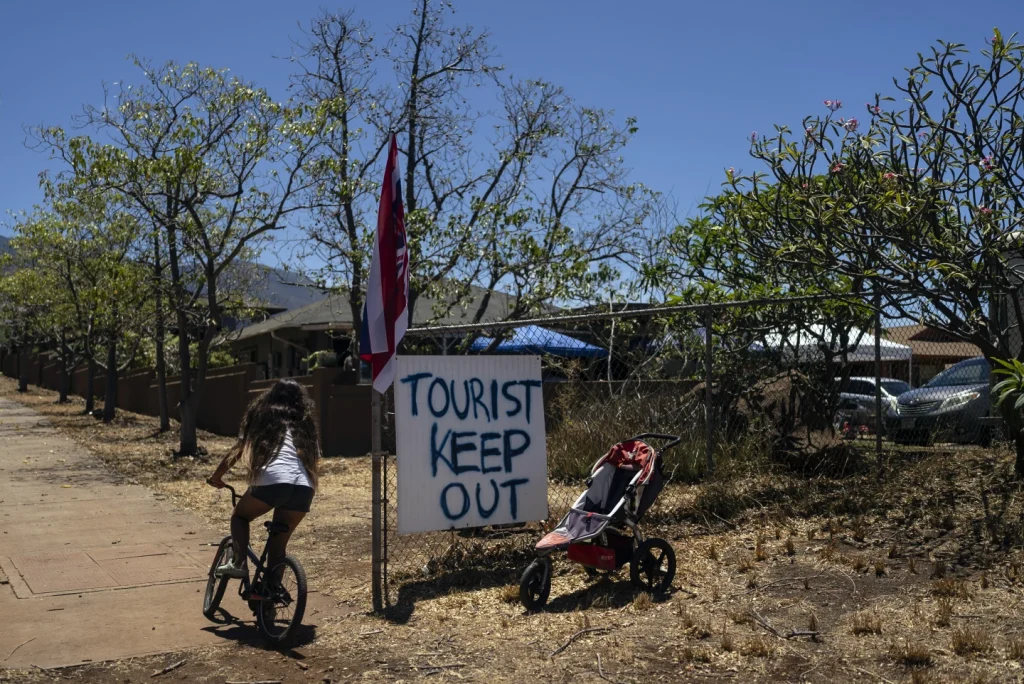The picturesque island of Maui, nestled in the heart of Hawaii, has long been a destination that captures the imagination of travelers from far and wide.
However, beneath its idyllic surface lies a complex dynamic between the island’s kamaaina, the cherished long-time residents, and the influx of visitors who have transformed their beloved beaches, mountains, and communities into bustling playgrounds.
This love-hate relationship, deeply rooted in history, has recently reached a boiling point in the wake of a devastating wildfire that ravaged the historic town of Lahaina, leaving behind a trail of destruction and claiming the lives of over a hundred individuals.
As the island grapples with the aftermath of this tragedy, the tension between the kamaaina and the tourists has become palpable, symbolized by the sight of a state flag fluttering upside down in the wind, a distress signal to the community.
Further emphasizing this divide, a hastily scrawled sign, adorned with blue paint, sternly warns tourists to “KEEP OUT,” a stark reminder of the deep-seated frustration and resentment that has been building over time.
The impact of tourism on local communities has been a subject of ongoing debate, and the recent events have only intensified this discussion.
Kapali Keahi, a resident of the affected neighborhood, expressed his concern about the negative consequences of tourism on the well-being of families and the sense of community.
Keahi emphasized the importance of prioritizing the needs of our loved ones, our ohana, during these challenging times. The devastating fire has left a lasting impact on those affected, including Keahi himself, who emphasized that they are still in the process of recovering from the trauma and adjusting to life after the disaster.
This statement highlights the urgent need to address the issues surrounding tourism and its potential hindrances to the local community’s ability to heal and rebuild.
The Maui Economic Development Board asserts that tourism is undeniably the driving force behind Maui’s economy. In the first half of 2023 alone, the island welcomed a staggering 1.4 million visitors.
This influx of tourists accounts for approximately 70% of the revenue generated in Maui, as reported by the board.
However, as the island embarks on the arduous journey of rebuilding, residents like Keahi are left pondering the role that tourism should play in the long-term recovery process. Experts emphasize that there is no straightforward answer to this complex question.
Rafael Villanueva, a member of the Tourism Expert Network, which offers consulting services to businesses such as hotels, explains that during times of disaster, it is crucial to temporarily halt all activities and focus solely on addressing the immediate aftermath.
However, there comes a point when the focus must shift towards rebuilding, which necessitates keeping people employed.
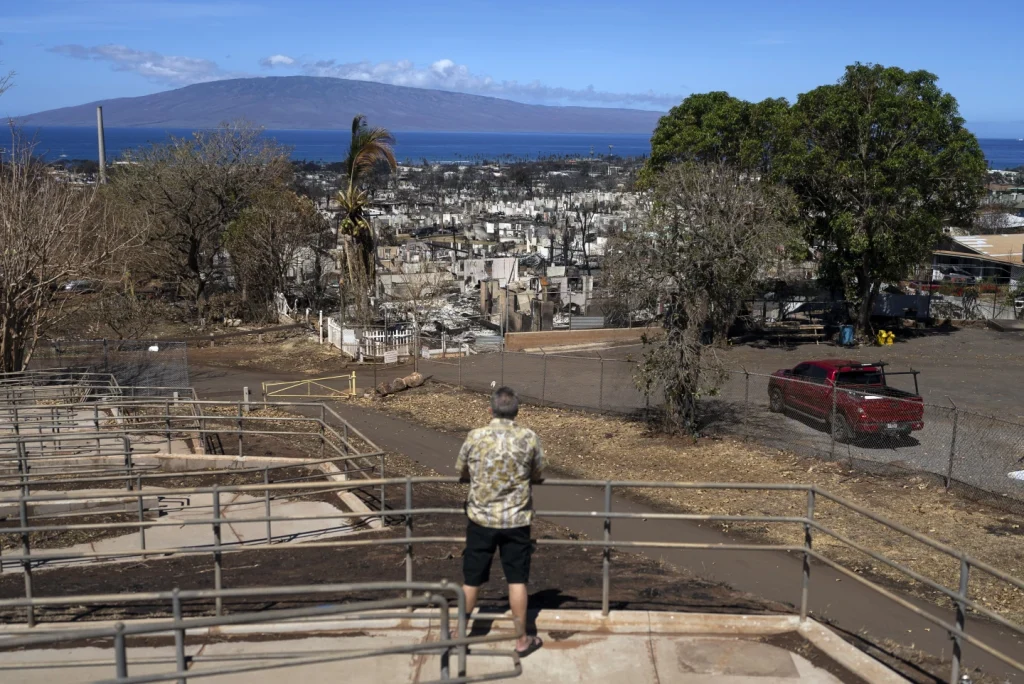
Villanueva draws from his experience working with the Las Vegas Convention and Visitors Authority in 2017, following the deadliest mass shooting in modern American history, which occurred at a country music festival on the Las Vegas Strip.
In that instance, the priority was to support the victims and the local community before considering the needs of tourists.
The delicate balance between prioritizing the well-being of residents and the economic benefits of tourism is a challenge that requires thoughtful consideration.
While the tourism industry undoubtedly provides employment opportunities and contributes significantly to the local economy, it is essential to strike a balance that ensures the long-term sustainability and resilience of the island.
As Maui moves forward on its path to recovery, it is crucial to heed the lessons learned from past experiences and devise a comprehensive strategy that supports both the local community and the tourism industry.
Only through careful planning and collaboration can Maui navigate the intricate web of challenges and opportunities that lie ahead.
In the wake of the tragic shooting incident that resulted in the loss of 60 lives and left hundreds more injured, the publicly funded organization responsible for promoting Las Vegas swiftly took action by halting its advertising campaign centered around the catchphrase “What Happens Here, Stays Here.”
Recognizing the need for a unifying message for the community, they promptly replaced the billboards with a powerful and resilient slogan: “Vegas Strong.” Furthermore, displaying remarkable solidarity and compassion, they opened up their convention center to serve as a hub for recovery efforts, including victim notifications.
However, as time progressed and the healing process began, the focus shifted towards reassuring visitors that Las Vegas remained a safe and secure tourist destination, inviting them back to the vibrant and resilient Strip.
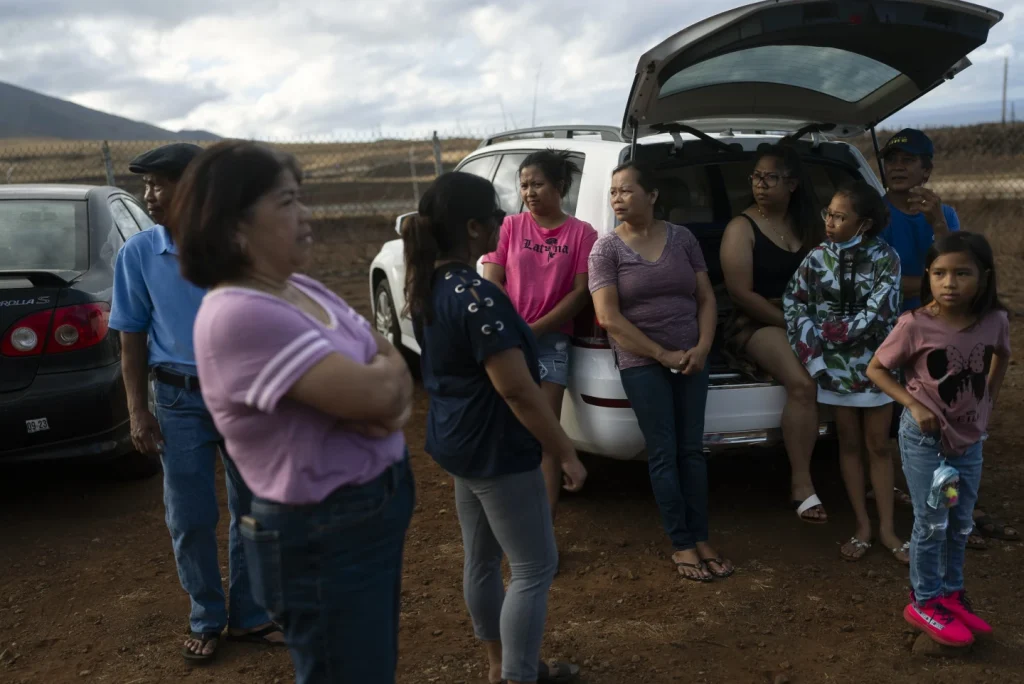
In a recent statement, Villanueva expressed the importance of taking immediate action to prevent the situation from escalating further.
The gravity of the situation cannot be understated, and it is crucial for all parties involved to be proactive in their efforts.
Meanwhile, Hawaii’s Governor, Josh Green, delivered a statewide address on Friday evening, urging tourists to steer clear of the fire-ravaged West Maui area. However, he reassured the public that the rest of the island and the state as a whole remained open and secure.
Green emphasized the significance of maintaining a steady flow of visitors to the state, as it would not only contribute to the local economy but also aid in the recovery process for those who have already endured substantial losses.
It is clear that both Villanueva and Green recognize the urgent need for immediate action and collaboration to address the ongoing challenges and ensure the well-being of the affected communities.
In light of recent events, Green, a prominent figure, has expressed concerns regarding the potential consequences of halting Maui’s tourism industry.
He strongly believes that such a move would be “catastrophic” and could result in a “mass exodus” of residents.
This sentiment is shared by many, including Maui resident Julie Sumibtay, who acknowledges the need for locals to have space to grieve and cope with their profound pain away from prying eyes.
However, Sumibtay also emphasizes the importance of sustaining employment opportunities for those who rely on the tourism sector.
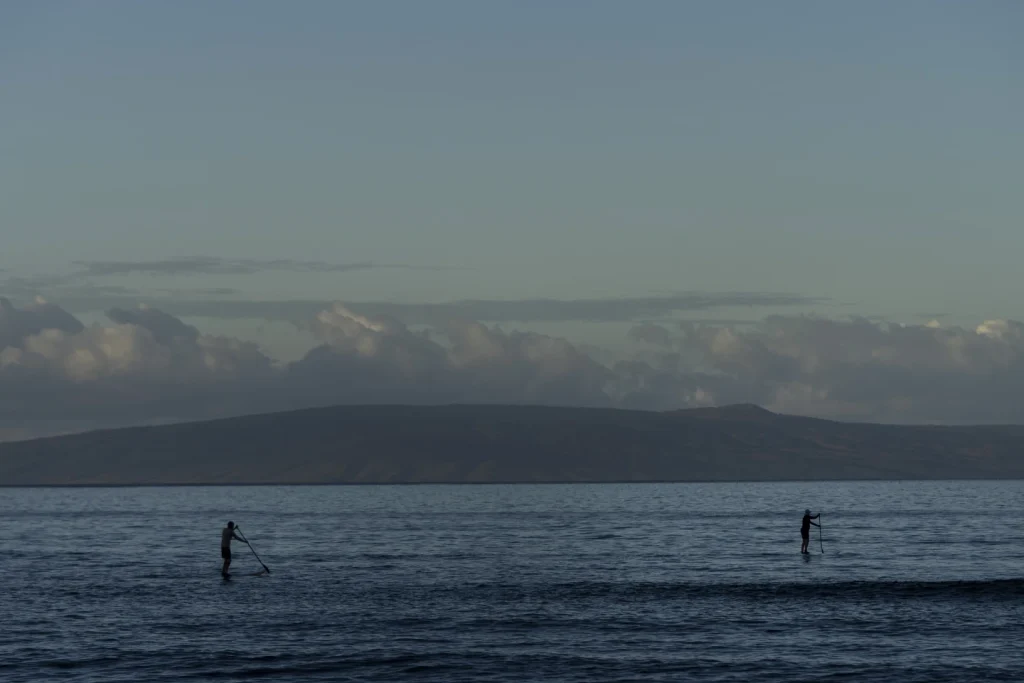
As a front desk employee at a condominium complex in Kihei, where some units are used for vacation rentals, she fears that a complete closure of Maui would lead to job losses.
The impact of the recent tragedy has already been felt, as some tourists have altered their plans and opted to visit other islands instead.
For instance, Tom Bailey and his family from Sacramento, California, arrived on Maui just a week before the devastating fire began to spread towards the historic town of Lahaina.
From the vantage point of their hotel in Kaanapali, just up the road from Lahaina, Bailey and his family were initially able to observe the distant smoke rising ominously into the sky.
At first, they found solace in the belief that the raging blaze posed no immediate threat to their safety. However, as the night wore on, the glow emanating from the fire grew increasingly intense, causing hotel officials to express concerns and recommend that guests consider a voluntary evacuation.
With a heavy heart and a sense of trepidation, Bailey and his family made the difficult decision to pack their belongings and bid farewell to their cherished vacation destination, opting instead to spend the remaining five days of their trip on the island of Oahu.
Bailey and his family embarked on a journey filled with anticipation and excitement as they meticulously packed their belongings, ready to embark on the final leg of their well-deserved vacation.
Their destination was the mesmerizing island of Oahu, renowned for its breathtaking landscapes, vibrant culture, and warm hospitality.
With each item carefully placed in their suitcases, their hearts fluttered with the anticipation of the adventures that awaited them.
The thought of spending the next five days exploring the pristine beaches, indulging in delectable cuisine, and immersing themselves in the rich history and traditions of this tropical paradise filled them with an overwhelming sense of joy.
As they bid farewell to their previous destination, they couldn’t help but feel a tinge of sadness, knowing that their time there had come to an end. However, the prospect of the upcoming days on Oahu quickly overshadowed any lingering feelings of melancholy.
The journey to the island was filled with anticipation, as they eagerly boarded the plane, ready to embark on a new chapter of their vacation. The plane soared through the sky, carrying them closer to their dream destination.
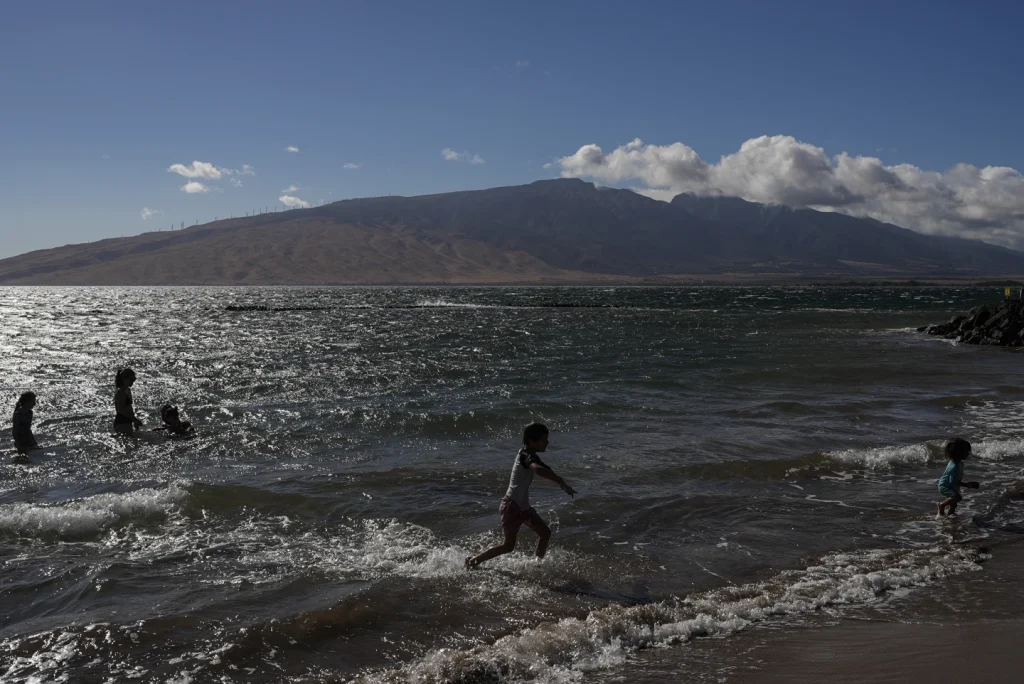
As they landed on the island, the warm breeze welcomed them, enveloping them in a comforting embrace.
They could already sense that their time on Oahu would be nothing short of magical. With the sun shining brightly overhead, they made their way to their accommodations, eager to settle in and begin their exploration of this tropical paradise.
The days ahead promised endless possibilities, with a myriad of activities and sights to discover. From hiking through lush rainforests to snorkeling in crystal-clear waters, each day would be a new adventure waiting to unfold.
Bailey and his family were determined to make the most of their time on Oahu, cherishing every moment and creating memories that would last a lifetime.
As they unpacked their belongings and settled into their temporary home, they couldn’t help but feel a sense of gratitude for the opportunity to experience such beauty and wonder.
The days that followed would be filled with laughter, relaxation, and a deep appreciation for the natural wonders that surrounded them.
From sunrise to sunset, they would immerse themselves in the vibrant culture of the island, savoring every experience and embracing the true essence of Oahu.
As they embarked on this final leg of their vacation, Bailey and his family knew that their time on Oahu would be an unforgettable chapter in their lives.
They were ready to create memories, forge new connections, and bask in the sheer beauty of this tropical paradise.
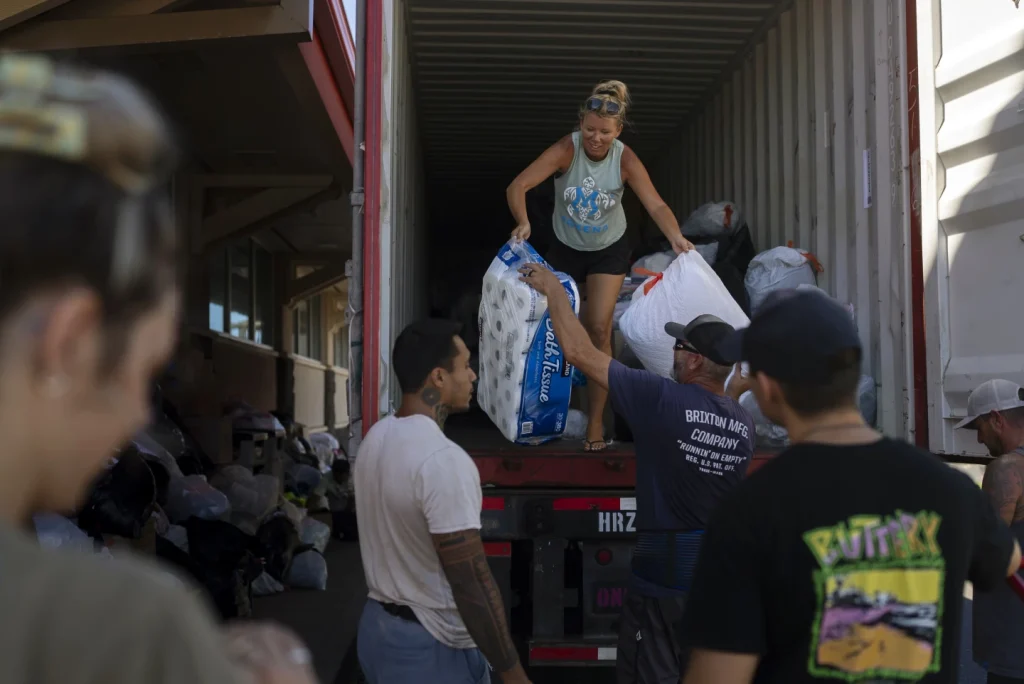
With hearts full of excitement and anticipation, they took their first steps on the sandy shores of Oahu, ready to embark on a journey that would leave an indelible mark on their souls.
Bailey expressed his intention to remain inconspicuous, emphasizing his understanding of the local residents’ requirement for space and time.
With a considerate tone, he acknowledged the necessity for individuals to process their experiences and emotions at their own pace.
By expressing their desire to avoid causing any disruption or interference, Bailey demonstrated a respectful attitude towards the community.
Recognizing the importance of allowing others the opportunity to adjust and adapt, Bailey’s words conveyed a sense of empathy and sensitivity towards the needs of the local residents.
